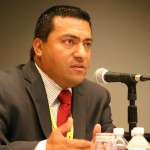WASHINGTON — California is shooting for a third of its energy to be produced by renewable resources by 2020, but renewable technologies like wind, solar and electric vehicles present a series of complex challenges to power and distribution companies, the smart grid policy manager for San Diego Gas & Electric said Thursday.
“California has a very aggressive energy policy,” Armando Infanzon told an audience at an annual renewable energy technology conference in Washington. San Diego residents are similarly progressive when it comes to adopting consumer renewables – the area boasts 10 percent of those waiting to take ownership of a Nissan Leaf, Infanzon said.
But charging an electric vehicle can add as much load to the grid as a house. Because renewable consumers tend to be concentrated in certain areas, these loads could cause grid stability issues, he said.
“Those electric vehicles can start creating problems and burning transformers,” Infanzon said. Similarly, as the variety of power supply sources increases, power reliability can be affected, he said, citing the dynamic nature of wind power as an example.
San Diego residents learned first hand the importance of power reliability when a major outage left 1.4 million SDG&E customers to swelter in a heat wave this month. The cause of that outage is under investigation, Infanzon said.
“One of the main objectives for smart grid is maintain and prepare reliability,” he said.
The concept of a smart grid can mean different things to different people, according to Jeff Taft, chief smart grid architect for Cisco Systems, Inc. Taft equates today’s emerging grid technology with the transformation from mechanically controlled airplanes to highly agile but unstable fighter jets that require precise electronic controls.
Turbines turned by oil, gas or nuclear combustion are stable and steady, while many of the new technologies are dynamic, Taft said.
“Life is getting a lot more complicated,” he said.
Distributors are adding sensors to measure load and supply across the grid as new suppliers come on line, resulting in a tsunami of data, which companies should embrace rather than run from, Taft said.
“We need that data, we shouldn’t be afraid if it,” he said, repeating the industry adage, “You can’t control what you don’t measure.”
As with the jet fighter, sorting out that data is the secret to maintaining control, he said. “We have to be agile for reliability’s sake.”
Managing the emerging grid presents new business opportunities. Under the traditional system, distributors vary rates to discourage suppliers from producing energy during off-peak hours, according to Chantal Hendrzak, general manager of applied solutions at PJM Interconnection, LLC, a major power transmission provider in the Midwest and Northeast. In rare cases in Chicago, her company actually charges suppliers if they contribute during periods of extremely low demand, she said.
Because of government subsidies, wind sources make money whether they are producing power or not, so they don’t respond to market prices, she said. Instead, a variety of innovations are being used to dampen fluctuations in supply and load.
The Mid-Atlantic Grid Interactive Cars Consortium studied grid-to-car programs that would pay people to charge their electric vehicles with smart chargers that provide either load or power from their batteries based on grid needs.
“We would be paying you to charge your car at that time of day because you are putting load onto the system,” she said. “We need that load for stability purposes.”
AES Corporation recently tested a 1-megawatt battery, housed in a semi-truck trailer. The company concluded it could make up to $500 a day by charging the battery during off-peak hours and giving back to the grid during high demand, Hendrzak said.

